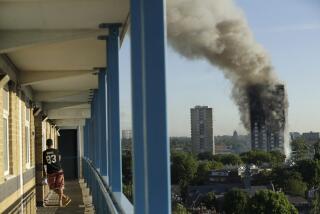Japan, utility at fault for response to nuclear disaster, report says
- Share via
REPORTING FROM SEOUL -- Japan’s response to the crisis at the Fukushima Daiichi nuclear power plant was flawed by poor communication and delays in releasing data on dangerous radiation leaks at the facility, which was struck by an earthquake-triggered tsunami on March 11, a government-appointed investigative panel has found.
The report attaches blame to both Japan’s central government as well as the utility that operates the plant -- the Tokyo Electric Power Co. -- depicting a scene of harried officials incapable of making decisions to stem radiation leaks as the situation at the coastal plant worsened in the days and weeks following the disaster.
The 507-page interim report, the product of interviews with hundreds of utility workers and government officials, said poor planning also worsened the disaster response, noting that authorities had grossly underestimated tsunami risks that followed the 9.0-magnitude earthquake.
The 40-foot-high tsunami that struck the plant was twice as tall as the highest wave predicted by officials. The erroneous assumption that the plant’s cooling system continued to function after the tsunami struck worsened the disaster, the report claimed.
The report, whose final version is due to be completed next year, also found that plant workers had no clear instructions on how to respond to such a disaster, causing miscommunications, especially when the disaster destroyed backup generators. Ultimately, the series of failures led to the worst nuclear catastrophe since Chernobyl.
Workers failed to immediately seek alternative sources of water to cool the overheating reactors because they assumed the system was working, even though numerous warning signs told them otherwise.
“This accident has taught us an important lesson on how we must be ready for a disaster,” concluded the panel, headed by University of Tokyo professor emeritus Yotaro Hatamura.
The government also received its share of criticism after dangerous radioactivity leaked into the atmosphere, causing the evacuation of 80,000 nearby residents, most of whom have still not returned to their homes.
Fearing a national panic, Tokyo government ministries failed to relay critical information to the public, instead using language that attempted to lessen the severity of the evolving crisis, which included meltdowns at three of the plant’s reactors.
Following the March 11 earthquake and tsunami, then-Prime Minister Naoto Kan and his advisors had stationed themselves on the fifth floor of the prime minister’s office, where they made key decisions in consultation with top ministers and Tepco officials. But the officials did not share information with other crucial ministries or even with the crisis-management headquarters set up in the basement of the office several floors below, the report said.
The panel also faulted government officials for delaying warnings on the spread of radiation in the region around the plant, unnecessarily exposing communities to exposure when they could have been immediately evacuated.
The panel recommended that the government and the utilities that run nuclear plants employ experts knowledgeable in assessing tsunami risks.
“The nuclear disaster is far from over,” the report concluded.
More to Read
Sign up for Essential California
The most important California stories and recommendations in your inbox every morning.
You may occasionally receive promotional content from the Los Angeles Times.













